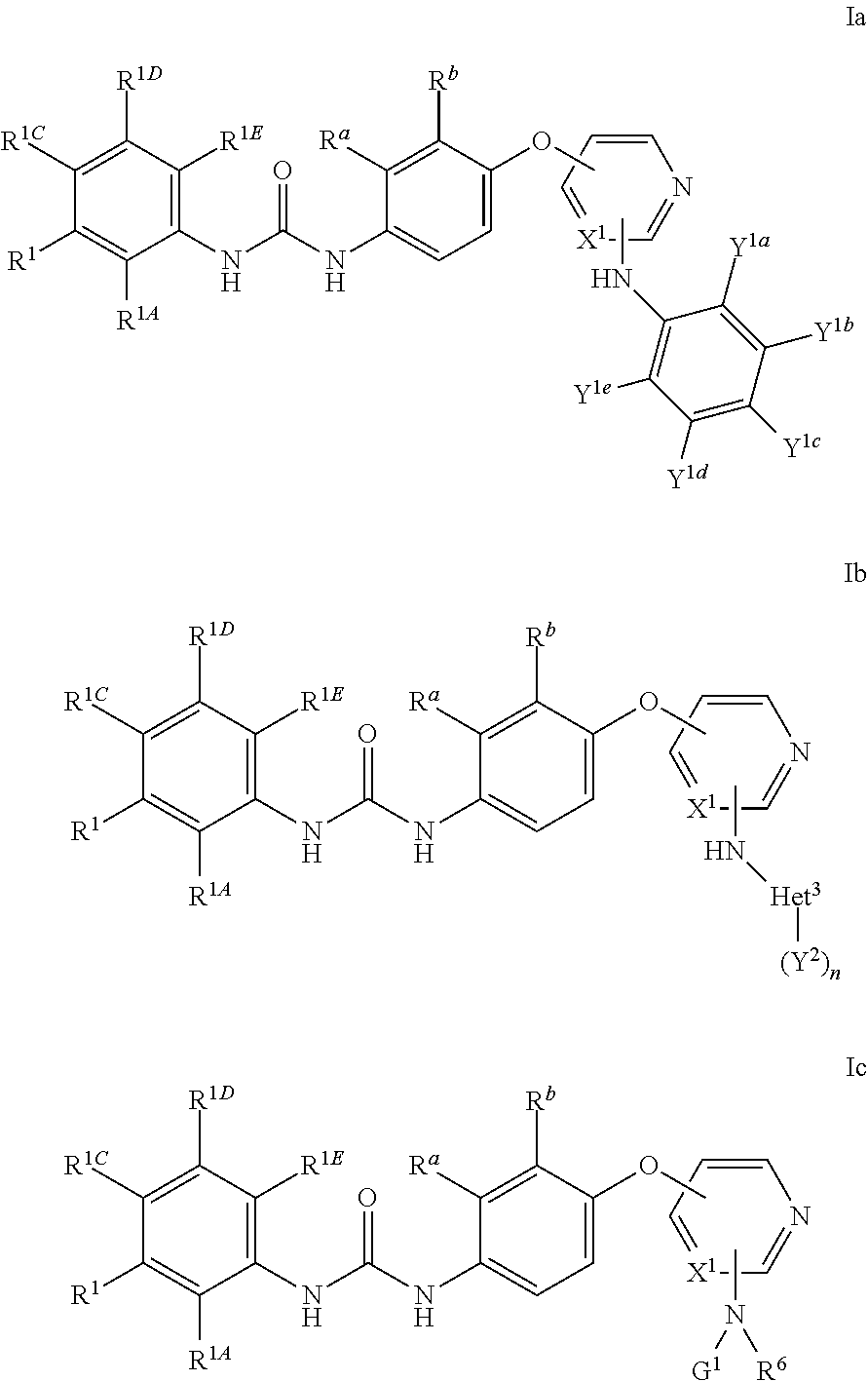Urea derivatives useful as kinase inhibitors
a technology of urea derivatives and kinase inhibitors, applied in the direction of group 5/15 element organic compounds, drug compositions, immunological disorders, etc., can solve the problems of high toxicity of inhibitors, hindering the utility of p38 map kinase inhibitors in the treatment of human chronic inflammatory diseases, and patient toxicity, etc., to achieve good anti-inflammatory effects
- Summary
- Abstract
- Description
- Claims
- Application Information
AI Technical Summary
Benefits of technology
Problems solved by technology
Method used
Image
Examples
example 1
1-(5-(tert-Butyl)-3-(dimethylphosphoryl)-2-methoxyphenyl)-3-(4-((2-((3-methoxy-5-(2-(2-(2-methoxyethoxy)ethoxy)ethoxy)phenyl)amino)pyrimidin-4-yl)oxy)naphthalen-1-yl)urea
[0766]
(i) 3-Methoxy-5-nitrophenol
[0767]A mixture of KOH (29.0 g, 517 mmol) and 1-bromo-3-methoxy-5-nitrobenzene (30 g, 129 mmol) in water (70 mL) and dioxane (70 mL) was degassed for 5 minutes prior to the addition of di-tert-butyl(2′,4′,6′-triisopropyl-[1,1′-biphenyl]-2-yl)phosphine (1.263 g, 2.97 mmol) and Pd2(dba)3 (1.184 g, 1.293 mmol). The resulting mixture was degassed for a further 2 minutes then heated under a nitrogen atmosphere at 100° C. for 2 h. The mixture was cooled, then acidified with 5M HCl to ˜pH 1 and extracted with EtOAc (2×500 mL). The organic layer was washed with saturated brine (200 mL), dried (MgSO4), filtered and concentrated under reduced pressure. The crude product was purified through a pad of silica eluting with 30% EtOAc / isohexane to afford the sub-title compound (20.76 g) as a yellow ...
example 2
1-(5-(tert-Butyl)-3-(dimethylphosphoryl)-2-methoxyphenyl)-3-(4-((2-((3-methoxy-5-(2-(2-(2-methoxyethoxy)ethoxy)ethoxy)phenyl)amino)pyridin-4-yl)oxy)naphthalen-1-yl)urea
[0790]
(i) 4-((2-Chloropyridin-4-yl)oxy)naphthalen-1-amine
[0791]KOtBu (25.8 g, 230 mmol) was added portionwise to a stirred mixture of 4-aminonaphthalen-1-ol hydrochloride (15 g, 77 mmol) in DMF (250 mL) at −20° C. under N2. The mixture was stirred for 20 min then 2-chloro-4-fluoropyridine (10.4 mL, 115 mmol) was added and the mixture warmed to 0-5° C. After stirring for 2 h, activated charcoal (20 g) was added, stirred for 30 min then filtered. The filtrate was partitioned between ether (400 mL) and water (400 mL), the ether layer was separated and the aqueous layer washed with ether (300 mL). The combined ether layers were washed with water (200 mL), dried (MgSO4) and activated charcoal (15 g) added. The mixture was stirred for 30 min then filtered and evaporated under reduced pressure. The residue was triturated wit...
example 3
3-((4-((4-(3-(5-(tert-Butyl)-3-(dimethylphosphoryl)-2-methoxyphenyl)ureido)naphthalen-1-yl)oxy)pyridin-2-yl)amino)-5-ethynyl-N-(2-(2-(2-methoxyethoxy)ethoxy)ethyl)benzamide
[0804]
(i) 3-Amino-5-((triisopropylsilyl)ethynyl)benzoic acid
[0805]Pd(PPh3)4 (9.36 g, 8.10 mmol) was added to a degassed suspension of 3-amino-5-bromobenzoic acid (50 g, 231 mmol), CuI (1.499 g, 7.87 mmol), and ethynyltriisopropylsilane (80 mL, 356 mmol) in triethylamine (300 mL) and DMF (300 mL). The mixture was heated to 90° C. for 2 h. The mixture was cooled and carefully poured into ice-cold HCl (2.0M aq.) (1100 mL, 2200 mmol) and diluted with diethyl ether (500 mL). The biphasic mixture was filtered to remove palladium residues. The layers of the filtrate were separated and the aqueous phase was extracted with a further portion of diethyl ether (300 mL). The organic phases were combined and washed with 20% brine (2×300 mL), 40% brine (300 mL), dried (MgSO4), filtered and concentrated in vacuo affording a pale ...
PUM
 Login to View More
Login to View More Abstract
Description
Claims
Application Information
 Login to View More
Login to View More - R&D
- Intellectual Property
- Life Sciences
- Materials
- Tech Scout
- Unparalleled Data Quality
- Higher Quality Content
- 60% Fewer Hallucinations
Browse by: Latest US Patents, China's latest patents, Technical Efficacy Thesaurus, Application Domain, Technology Topic, Popular Technical Reports.
© 2025 PatSnap. All rights reserved.Legal|Privacy policy|Modern Slavery Act Transparency Statement|Sitemap|About US| Contact US: help@patsnap.com



